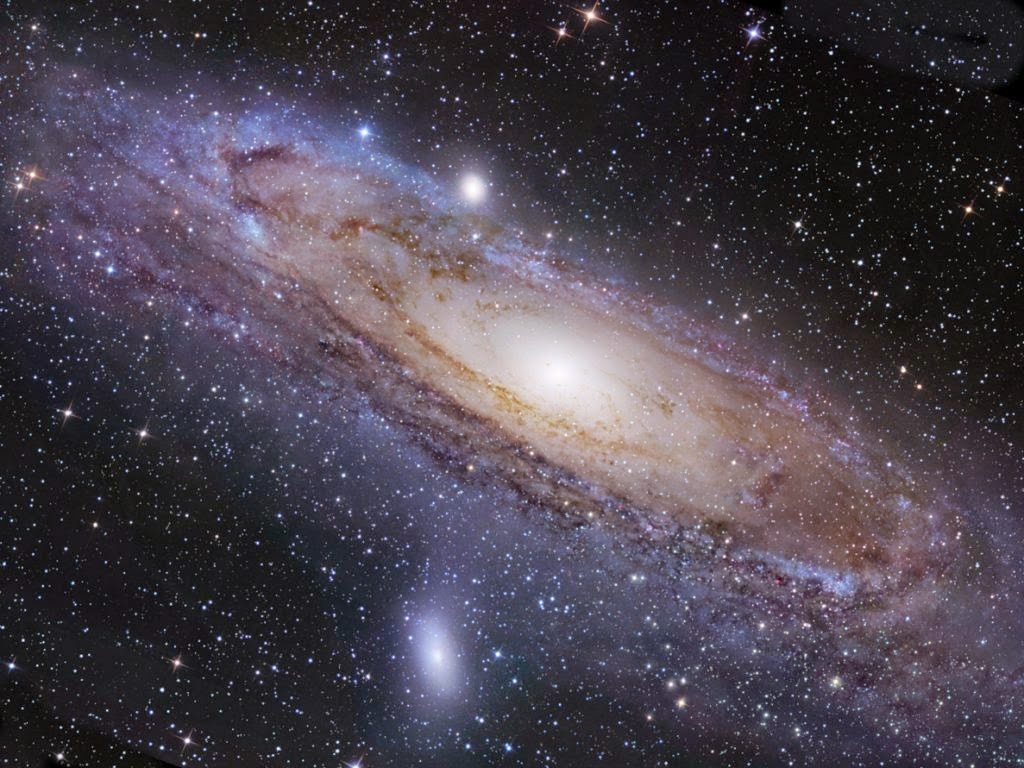On January 5, 2015, NASA wowed the world with ‘the largest picture ever taken’ in human history - a panoramic picture of the Andromeda galaxy, measuring 1.5 billion pixels (a high quality Canon SLR takes 20-megapixel [=20 million pixels] photos) and requiring 4.3 GB of disk place. The giant mosaic - 411 images put together - was taken by the NASA/ESA Hubble Space Telescope from low Earth orbit.
 |
A stunning image of a corner of Andromeda captured by the Hubble Space Telescope. Credit: NASA
|
The image captures one third of the Andromeda Galaxy, showing her central galactic bulge on the left and the galaxy’s outskirts on the right - and every star, sparkle and stardust in between. You would be amazed to know that this extremely high-res photo contains 100 million stars from our neighbor galaxy… you’ve got to see it to believe it! Watch the video as the camera zooms in, then pans from the right to the left as the the stars get denser and denser, eventually replacing specs of light in the dark blue cosmic sky with a carpet of golden jewels.
Most call her Andromeda, also known as M31 by her nerdy fans - a beautiful daughter of a North African king in Greek mythology, it is the closest spiral galaxy to our Milky Way Galaxy, a “mere” 2.5 million light-years away. This is where most people become misled - it is the closest SPIRAL galaxy only - our closest galaxy is actually the Canis Major Dwarf Galaxy, which is obviously not spiral and probably majorly dwarf.
This girl next door is quite the giant, she measures 220,000 lightyears in diameter. Along with the Milk Way, they are the largest galaxies in the Local Group. What is the Local Group? It’s just the way we group galaxies in terms of scale. Simply put, Earth is within the Solar System, which is within the Solar Interstellar Neighborhood, which is within the Milky Way Galaxy, which is within the Local Galactic Group. Or see the illustration below.
(What if inhabitants of Andromeda one day find us and come visit us on Earth. Will they then be considered “local” or “alien”….? Hmmm. )
 |
| brighthub.com |
Andromeda (M31) vs Milk Way
# of stars: Andromeda - one trillion; Milky Way - 400 billion
Amount of dark matter - data unstable, but earlier findings suggest Milky Way has more
Solar masses - Milk Way wins (8.5×1011)
.jpg) |
| Andromeda (M31). Credit: NASA |
As a matter of fact, Andromeda (M31) is quite the queen bee. She was formed by violently colliding into another galaxy 8 billion years ago (“oops!”), which produced most of her stars. When her long-time neighbour Triangulum Galaxy (M33) bypassed her “zone” 3 billion years ago (“watch it!”), Andromeda flipped (metaphorically) and disturbed M33’s outer disk, causing another wave of star formation. One after the other she "satellised", M32 and M110 followed suite, not to mention all the other smaller galaxies she absorbed over the lightyears. But to be fair, M33, M32 and M110 did not go down without putting up a fight - they distorted Andromeda’s spiral pattern during the interactions (“mwahaha”), which explains why her cross-section looks like an S-shape as opposed to a flat disk.
The bullying seems to have stopped. She has now established herself as one of the most luminous and iconic deep sky objects as viewed by the naked eye.
 |
| Current view of the night sky with Andromeda showing off her luminosity next to the Milky Way belt. Our neighbor is 2.5 million light years away and expected to crash into us in 4 billion years. Credit: Blip TV |
As much as we strive to love our neighbor as ourself, sometimes clashes are unavoidable, literally. Milky Way and Andromeda are predicted to collide, eventually merging into one huge elliptical galaxy ("Milk-omeda") in about 4 billion years (just about the same time it took to make Earth). Ok, so humankind has 4 billion more years to live, if we don’t get hit by an asteroid (2014 EC), or get fried from ozone-depletion, or kill each other off in a nuclear war, or get wiped out by a giant volcanic eruption (Yellowstone), global pandemic (Ebola, The Flu), overpopulation, etc. It’s a miracle we are still alive.
So brightly Andromeda shines in the night sky. Next time you look up on a clear night, spot the fuzzy bright disk - that’s the girl next door in all her swirly splendor.
 |
| Do you see her? Right there on top right! This is a telephoto of the southern Alps in Tyrol, Austria. Apart from Andromeda, on the top left you can see the Double Star Cluster. What an amazing photo!!! Credit: TWAN twanight.org?id=3003880 |
Sources:
NASA


.jpg)

